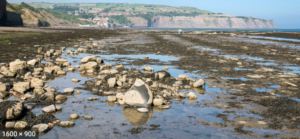“As steady as the tides, life continually
discovers the treasures within us!”
It’s late afternoon when we finally decide to go down the street to the beach. The routine is familiar; the wolf pups ride ahead on their scooters and leave them in the sand at the edge of the path leading to the beach. There is a sense of familiarity that returns as I arrive and survey the landscape. A southwest wind greets me and the salt air has an immediate calming effect. A line of demarcation, evidenced by seaweed, shells and a few pieces of driftwood, marks the extent of the previous high tide. The charred remains of an evening beach fire a few nights previous, and the shell of a dead hermit crab, already picked clean by the seagulls, completes the landscape.
Small waves are breaking close to the shore, and I can already see the shell remnants and pebbles that will mark low tide. The wolf pups scurry about the beach and test the still cold waters of the Nantucket Sound. Their decision to enter the water draws their father in, and me to the water’s edge. As the afternoon progresses, sand castles and moats will be built to face the high tide that will rise in a few hours. Like the seaweed, shells and anything else left at the water’s edge, tonight’s tide will remove them and leave behind new artifacts to be discovered and pondered on another day. But sometimes the greatest treasures are to be found during the low tide.
A quick glance down the beach reveals a series of large boulders placed closely together and, resembling a pier, running some thirty to fifty yards out from the water’s edge. This is the Bank Street Jetty and it helps to control the beach erosion created by the ocean’s changing tides, storms and currents; it is also a place where we can find hidden treasure left by the departing high tide. At the tidal crest, the ocean almost covers the rocks, sea waves crashing upon it. But it is at low tide that the true beauty of the jetty is revealed. It has become a home for seaweed, mussels and barnacles. In the small tidal pools surrounding it, sea snails, crabs, and small fishes scurry about. If you look carefully, among the broken clam shells, intact scallop shells abound and you can often find a colorful sea stone washed smooth by years in the sandy waters. For me, the value will not be found in the treasures, but in the memories of watching children poking, prodding and celebrating their discoveries. High tide will soon return and with it the cycle of life on the jetty will continue.
Like the tides, life is composed of other perpetual ebbs and flows; be it the changing of seasons, the cycle of life and death or periods of happiness and sorrow. As we gain life experiences (a nice way of saying as we get older) we are better able to flow with the tide. In our younger years we sought a life that represented a continual incoming or high tide, as it was difficult to understand the value of loss. Hence, we falsely concluded that the high tide is good and the subsequent low tide is bad. Perhaps because often, during our lowest periods, we are the most exposed and challenged. However it is during that same time that we often gain a better understanding of our inner strengths, our resilience and our ability to grow and move forward. In other words, it is during the low tides in our life that we discover our treasures within.
The nature of tidal change reinforces a cycle of life. The new incoming tide can wash away our regrets and give us a new beach on which to walk, while the low tide exposes treasures which otherwise would have gone unnoticed. You see, it is not the high or low tides in our life that make the difference, rather it is how we use the timeframe within the tide. How will you use yours?

